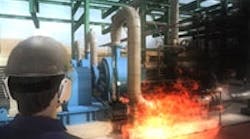ON-SITE DEPLOYMENT
Figure 2. Kiosk enables both new and experienced operators to sharpen their skills. Source: Invensys.
"All operators who had used PCs before were capable of 'walking inside' with barely half a day of introduction to the tool because of its highly intuitive interface and functionality access. The operators readily embraced the tool and described the training environment as very practical, as opposed to theoretical. Though of course, the two are necessary to provide the operator a more-comprehensive understanding of the meaning and granularity of their tasks and duties," explains Geiss.In addition, the instructor effectively was able to look over the operators' shoulders by observing their individual screens, following their actions in real time, and creating procedures with prompts to guide operators through their tasks. While COMOS Walkinside currently is better known in the oil and gas industry, Geiss believes the chemical industry presents a huge opportunity for the technology — one that can only grow in the future as the industry has to juggle increased environmental regulation, raw material availability, the use of new materials, and fluctuating price and cost trends. "Changing market requirements are presenting ever new challenges for enterprises in the industry — and that opens up new opportunities for 3D visualization technology."
NEW MODELING CAPABILITIESTwo years ago, Invensys, London, U.K., started to pilot its SimSci-Esscor Kiosk 3D simulation training with ENI at the Italian company's Gela refinery on the southern coast of Sicily. By using and applying gaming and other skill sets more familiar to younger employees, EYESIM is designed to appeal to both new and more-experienced engineering staff (
Figure 2)."Invensys has since delivered four additional Kiosk units to other refineries in the ENI group and has recently also provided one to an upstream oil and gas company based in the U.K. to help them evaluate the competency of their offshore operators," explains Richmond.The firm also has developed a 3D visualization tool for advanced understanding of a pressurized water reactor (PWR) for a training and service provider to the nuclear industry. "This project couples high-fidelity dynamic simulation of the reactor with a powerful 3D GUI [graphical user interface] that allows dynamic visualization of the behavior using transparency, color coding and dynamic animation," he adds. Also new is the EYESIM e-learning generic virtual crude unit system that has just been delivered to a major petrochemical company in Japan. This system enables a classroom of ten operators to self-train on both control room and plant scenarios based on a high-fidelity dynamic process model and a virtual reality model of a crude unit.The benefits of such training are easily identified, he says, because better-trained operators will lead to safer and more efficient operation of plant assets. "To quantify those benefits, however, is a more subjective exercise. If a plant were to analyze their unplanned shutdowns, lost production, near misses and accident data, they would find that human error was a significant factor and that both control room and outside operators contribute to those incidents." However, chemical manufacturers normally wait until technology has been proven elsewhere before investing in it, he notes. "For that reason, the companies we work with today come from forward-looking technology groups or with a budget taken from innovation resourcing. The cost of these latest developments is on par or less than for the equivalent control-room-operator training systems. This means that we are able to provide a higher service at the same market price point."Invensys is focusing continuing development of EYESIM in four main areas.First is a selection of new virtual-reality capabilities. Each new version of the engine includes faster rendering, shorter loading and enhanced animation and visualization of the virtual environment. "These all lead to a more-immersive environment to improve the training realism," Richmond emphasizes.Second is the provision of a more-powerful software development toolkit, which helps both to further automate the engineering process and reduce the cost of finding a solution.Third is improved usability. Enhanced features include newly designed instructor station, iPad/iPhone (
Figure 3) and tablet interfaces, location maps and contextual help.






